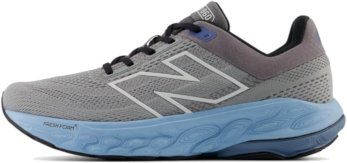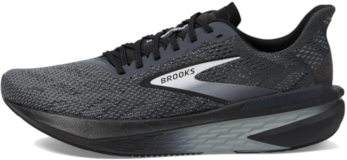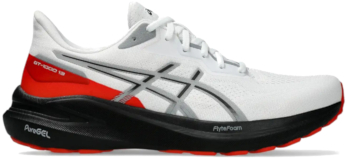The latest innovations in stability running shoes incorporate advanced materials and technologies that enhance comfort, support, and performance compared to traditional stability running shoes. These innovations often feature lighter, more breathable materials that reduce fatigue and improve overall fit.
Additionally, many new models utilize dynamic support systems that adapt to the runner’s gait, providing targeted stability without the bulk commonly associated with traditional designs. Enhanced cushioning technologies also help to absorb impact more effectively, reducing the risk of injury.
While there may only be a couple of true stability shoes that you can use for serious speed work, their new technologies are moving towards making them lighter and faster, with subtle corrections to your stride. Ultimately, modern stability running shoes offer a more responsive and customized running experience, appealing to both casual runners and serious athletes.
Understanding Overpronation
What is Overpronation?
Overpronation refers to the excessive inward rolling of the foot during the walking or running cycle. It occurs when the arches collapse, causing the foot to flatten more than normal. This biomechanical issue can lead to various foot, knee, and hip problems, as it alters the natural alignment and movement patterns. Athletes and active individuals may experience discomfort or injuries such as plantar fasciitis, shin splints, or knee pain due to overpronation. Proper footwear, orthotics, and strength training can help manage and correct overpronation.
Causes and Effects of Overpronation
Overpronation occurs when the foot rolls inward excessively during walking or running. Causes include flat feet, weak arches, improper footwear, and genetic factors. Effects can lead to various issues such as plantar fasciitis, knee pain, shin splints, and an increased risk of ankle sprains. Corrective measures include supportive footwear, orthotics, and specific exercises to strengthen the foot and leg muscles.
Identifying Your Pronation Type
To identify overpronation, follow these steps:
- Wet Foot Test: Wet the bottom of your foot and step onto a piece of cardboard or paper. Observe the footprint. If you see a large area connecting the heel and forefoot, it indicates overpronation.
- Wear Pattern on Shoes: Examine the soles of your shoes. Overpronators typically show excessive wear on the inner edges of the soles.
- Video Gait Analysis: Record yourself running or walking from the front and side. Look for excessive inward rolling of the ankle or foot.
- Professional Assessment: Consult a podiatrist or a specialized running store for an analysis of your gait and foot mechanics.
- Foot Flexibility Test: Stand barefoot and try to touch your toes. If your feet roll inward significantly while bending, it may indicate overpronation.
Importance of Choosing the Right Running Shoes
Impact on Performance
Choosing the right running shoes based on performance involves several key factors:
- Cushioning: Assess the level of cushioning you prefer based on your running style and distance. More cushioning offers comfort for long distances, while less is better for speed.
- Fit: Ensure the shoes fit well with enough room in the toe box and a snug heel to prevent slipping.
- Weight: Lighter shoes improve speed but may offer less support. Balance weight and support based on your performance goals.
- Drop: Analyze the heel-to-toe drop. A lower drop encourages a more natural running form, while a higher drop provides more cushioning for heel strikers.
- Brand and Model: Research reputable brands and specific models that cater to your performance needs, as different brands may fit differently.
Preventing Injuries
Choosing the right running shoes is crucial for injury prevention. Follow these guidelines:
- Cushioning and Support: Look for shoes with adequate cushioning and support based on your foot type and running style.
- Fit and Comfort: Ensure there is enough room in the toe box. Shoes should feel comfortable right away, without the need for a break-in period.
- Test Them Out: Run a few laps in the store or on a treadmill to assess comfort, fit, and support.
- Replace Worn Shoes: Check your shoes’ mileage regularly. Replace them every 300-500 miles to avoid injury from worn-out cushioning.
- Seek Professional Advice: Consult with a podiatrist or a running coach if you have a history of injuries.
Enhancing Comfort
Choosing a comfortable running shoe involves several key factors:
- Fit: Ensure there is enough space for your toes (about a thumb’s width), and the shoe should feel snug but not tight around the midfoot.
- Cushioning: Choose the level of cushioning based on your running style and preferences; more cushioning can provide comfort, while less can offer better ground feel.
- Weight: Lighter shoes can enhance speed but may provide less support; balance weight with comfort based on your running goals.
Key Features to Look for in Running Shoes for Overpronation
Arch Support
For runners with overpronation, look for shoes with stability or motion control features. These types of shoes typically provide firmer arch support and additional cushioning to help stabilize the foot and control excessive inward rolling during the running stride. Key characteristics include a supportive midsole, a medial post for extra support on the inner side, and a structured heel counter to maintain alignment. Consider brands that specialize in overpronation support, and always ensure a proper fit to enhance comfort and reduce the risk of injury.
Cushioning
The shoes with the right cushioning have additional arch support and a structured heel to maintain proper alignment. A good choice of materials should provide shock absorption while allowing for flexibility in the forefoot. It’s crucial to ensure that the cushioning is responsive enough to handle the impact during runs, while also providing support to prevent injuries.
Stability and Motion Control
Stability and motion control features in running shoes are designed to support the foot and prevent excessive inward rolling. Stability shoes typically include a firmer midsole on the medial (inner) side, which helps guide the foot into a more neutral alignment during the running gait. Motion control shoes offer additional support, often featuring a more rigid structure that limits excessive motion.
By providing these features, running shoes help maintain proper biomechanics, reduce strain on the arches, and minimize the risk of related injuries such as plantar fasciitis or shin splints. Properly fitted stability or motion control shoes can enhance overall comfort and performance for runners prone to overpronation.
Fit and Comfort
Fit and comfort play crucial roles in preventing overpronation. Properly fitting shoes provide the necessary support and stability to the foot, reducing excessive inward rolling during walking or running. Comfortable footwear encourages a natural gait, allowing for even weight distribution and minimizing strain on the arches. Selecting shoes with appropriate cushioning and arch support can help align the foot correctly, reducing the likelihood of overpronation and associated injuries.
Top Recommendations for Running Shoes for Overpronation
Best Overall Running Shoe
— New Balance 860v14 —

The New Balance 860v14 is one of the best running shoes for overpronation due to its combination of stability, comfort, and cushioning. If you have moderate to severe overpronation, this is the running shoe for you because it has true medial support that helps align the foot so you won’t have running-related pains even if you overstride. And it’s the only recommended shoe for plantar fasciitis on this list.
This shoe features a supportive Fresh Foam X midsole that provides soft landings and responsive takeoffs, helping to correct overpronation without sacrificing comfort. Its medial post design offers additional support for the arch, promoting a more natural foot motion. The engineered mesh upper also enhances breathability while ensuring a snug fit, reducing the risk of blisters during long runs.
Shop On ZapposBest for Speed Work
— Brooks Hyperion GTS 2 —

The Books Hyperion GTS 2 is the lightest and fastest stability running shoe, weighing only 7.6oz. It features a lightweight mesh upper that enhances breathability while providing a secure fit. The shoe incorporates nitrogen-infused DNA FLASH v2, a responsive cushioning technology that maximizes energy return, allowing for quicker transitions and a faster tempo.
Additionally, it uses GuideRails system, a strategically positioned support that guides the foot without adding unnecessary weight, ensuring a smooth and efficient running experience. The combination of these elements results in a shoe that promotes speed while maintaining stability, making it ideal for competitive runners.
Shop On ZapposAlternative: The other light and fast stability running shoe that feels as springy and energetic as the Brooks Hyperion GTS 2 is the Saucony Tempus 2. It only weighs 8.9oz and uses a contoured PWRRUN frame and structured cushioning that work well with overpronators.
Best Budget-Friendly Option
— Asics GT-1000 13 —

The Asics GT-1000 13 is the best budget-friendly stability running shoe because it costs $110 only yet feels more lively and energetic compared to many budget shoes. It features a 3D Guidance System that enhances stability while minimizing weight, effectively controlling overpronation. The shoe’s FlyteFoam technology provides responsive cushioning, ensuring a comfortable ride over long distances. Additionally, the breathable mesh upper keeps feet cool and dry, while the durable outsole offers excellent traction on various surfaces.
Shop On ZapposBest for Long Distances
— Saucony Guide 18 —

The Saucony Guide 18 is acclaimed for its exceptional stability and comfort, making it one of the best choices for long-distance running. It features a broad base platform underfoot with higher sidewalls that provide support for overpronators, preventing common injuries associated with excessive inward rolling of the foot.
The shoe incorporates a lightweight yet durable engineered mesh upper, ensuring breathability and a snug fit during extended runs. Its cushioning technology, such as the PWRRUN midsole, offers a perfect balance of softness and responsiveness, absorbing impact while maintaining energy return. The outsole’s rubber traction provides excellent grip, enhancing stability on various surfaces.
Shop On ZapposBest for Heavy Runners
— Asics Gel-Kayano 31 —

The Asics Gel-Kayano 31 is widely regarded as the best stability running shoe for heavy runners due to its maximum cushioning, support, and durability. The shoe features advanced Gel technology that absorbs shock, reducing impact on joints during runs. Its new 4D Guidance System enhances stability without compromising comfort, making it ideal for heavier runners who require adaptive, on-demand stability.
The breathable engineered mesh upper ensures a comfortable fit, while the robust outsole, which features Hybrid AsicsGrip, provides excellent traction and longevity, allowing for a smooth and reliable running experience. Overall, the Gel-Kayano 31 combines performance and comfort, making it the top choice for stability in heavy runners.
Shop On ZapposHow to Properly Fit Your Running Shoes
Measuring Your Feet
To fit your running shoes properly, follow these steps:
- Measure Your Feet: Use a Brannock device or a measuring tape to measure both the length and width of your feet. Always measure in the afternoon when your feet are slightly swollen.
- Consider Your Socks: Wear the type of socks you plan to run in when trying on shoes to ensure an accurate fit.
- Choose the Right Size: Your running shoes should be a half to a full size larger than your regular shoes. There should be about a thumb’s width of space between your longest toe and the end of the shoe.
- Check the Width: Ensure the shoes are snug but not tight. Your foot should feel secure without pinching or rubbing.
- Check for Arch Support: Assess whether the shoe provides adequate arch support for your foot type
- Break-In Period: Remember that running shoes should feel comfortable right away, though they may require a short break-in period.
Trying on Shoes
Trying on shoes before buying is crucial for several reasons. First, it ensures the right fit, helping to avoid discomfort and potential foot problems. Second, it allows you to assess the shoe’s support and cushioning, which can vary significantly between brands and styles. Lastly, trying on shoes helps you gauge how they feel during movement, ensuring they meet your needs for activities like walking or running.
Assessing Fit and Comfort
To assess fit and comfort in a running shoe, follow these steps:
- Measure Your Feet: Measure both feet while standing. Note the length and width of the wider foot.
- Try Shoes in the Afternoon: Feet swell throughout the day, so try on shoes in the afternoon for a more accurate fit.
- Wear Proper Socks: Use the type of socks you’ll wear when running to ensure the best fit.
- Check the Toe Box: Ensure there’s about a thumb’s width of space between your longest toe and the front of the shoe. Your toes should not feel cramped.
- Heel Fit: The heel should feel snug without slipping. Walk around to assess how the heel fits as you move.
- Midfoot Support: Ensure the midfoot area feels secure without excessive tightness.
- Flexibility: Bend the shoe at the ball of the foot. It should flex easily but not too much.
- Cushioning: Press down on the insole to check for adequate cushioning that feels comfortable underfoot.
- Test for Comfort: Walk or jog around the store for a few minutes. Pay attention to any discomfort or pressure points.
- Assess Overall Feel: The shoe should feel like an extension of your foot, with no pinching or excessive movement.
Conclusion
Overpronation can lead to excessive inward rolling of the foot, causing instability. But proper shoes provide the necessary support to maintain foot alignment. Quality running shoes designed for overpronators help absorb shock and reduce the risk of injuries. These running shoes are tailored for overpronation and offer additional cushioning and support, leading to a more comfortable running experience. The right footwear can enhance your running efficiency, allowing for better performance and endurance.
You may also like: